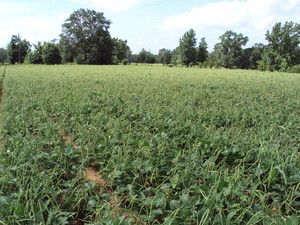05 Nov Thu 2009
A New Beginning
Last summer's drought was very bad for us. The green beans and sweet corn were up and doing nicely, then it stopped raining. The weather remained dry throughout the summer, so dry that we did not attempt replanting.Summer is gone now and fall has taken its place. We set to work planting a heavy cover crop as a green mulch. This will be rolled down and killed in the spring, allowing us to no-till beans and sweet corn into the mulch.
We will follow the green beans and corn with purplehull peas.A few garden vegetables will be planted in the garden and the edamame will be raised on the far south side. SInce we usualy have very wet winters, we have decided to introduce fava beans and english peas into the winter garden. Other crops are being evaluated as well. We want to try and raise some sweet potatos and green beans for a Thanksgiving next year if we can work them inton the rotation. So much depends on available moisture.
All is quite on the farm forn the moment, except for all the excitement that was generated on te delivery of a 1991 Pixall BigJack generated in the community. No one hear had ever seen such a machine! Never mind the excitment the one row picker generated two years ago. I don't own the Big Jack, I am showing the machine for a business partner of mine from Topeka, Kansas who deals in this kind of equipment. It is a very used machine that may not be capable of 1000 acre picking anymore but certainly is capable of picking 20 to 200 acres every year without excessive maintenance costs. It fills a niche between the one row picker at $30,000 and the new Big Jack at $300,000.
Why use machines? Because picking crews are difficult to come by, exposes the farm operator to immigration issues, heathcare issues ect. The machines are far more reliable, and work in dark or wet conditions, and leave very little product in the feild.They are always ready. Reliable. As we become a year round operation a machine that can do more than one thing will become indespensable.

